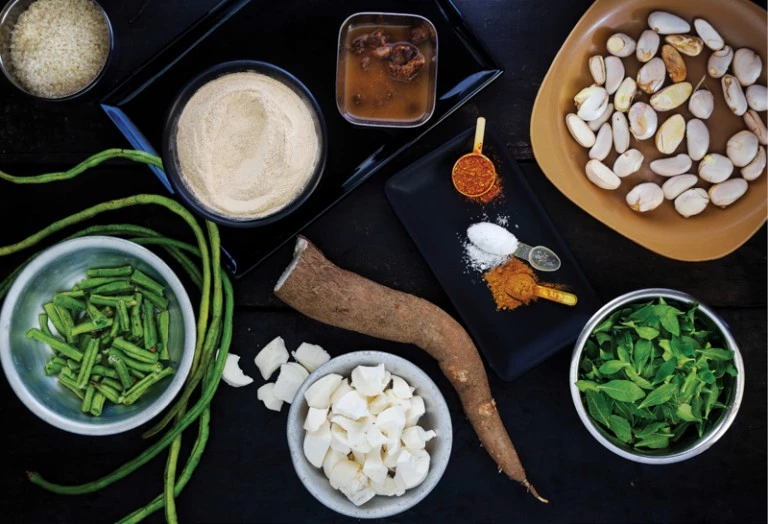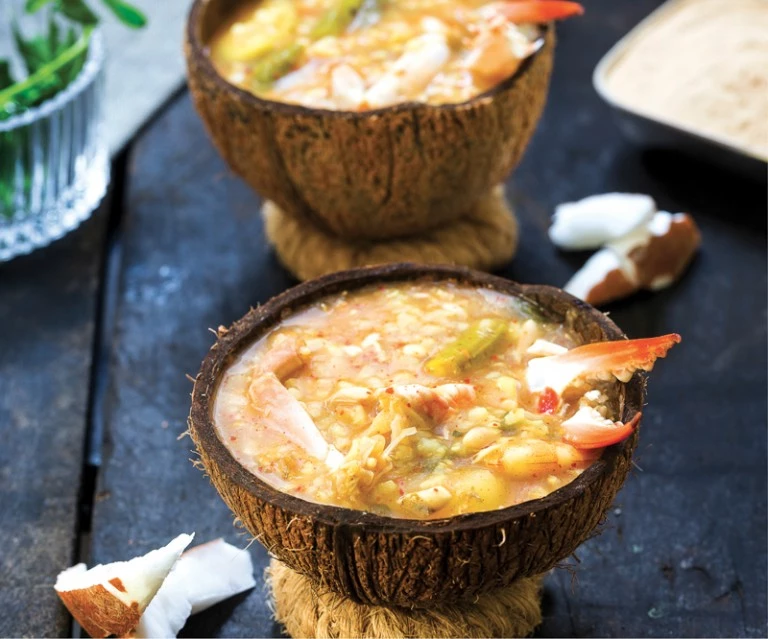
Jaffna’s odiyal kool is so nutritious and filling, it’s a meal in itself
Words Daleena Samara | Photographs Rasika Surasena

Odiyal kool is Jaffna’s match for French bouillabaisse. The choice of exotic local ingredients sets this extraordinary seafood soup apart and makes it a representative dish of Sri Lanka’s northernmost city. But there’s more to it: the rich combination of ingredients makes kool very filling and nutritionally supercharged, and so it’s seen as a complete meal on its own. Odiyal kool is your lunch in a soup bowl.
Originating from Jaffna, kool (pronounced ‘koozh’) captures the essence of its birthplace. In it are the spirit of the northern seafood industry, the palmyra palms and the earthy flavours of simple everyday foods like jackfruit, cassava and string beans (mae-karal). The mix is unexpected and the taste unprecedented. If you’ve had curry upon curry, you’ll find this dish lacks the usual flavours of spices like coriander, cardamom and cumin, but is nevertheless incredibly tasty in a very unusual way.
The lengthy list of ingredients makes it somewhat troublesome to prepare; the origins of kool hark back to unhurried times when the extended family lived communally, sat around and shared a huge pot of kool for lunch. In the laid-back life of yesteryear, time wasn’t as pressing a concern as today. Today, few take the trouble; as a result, kool is a rare delicacy. It’s the exceptional home that prepares kool regularly.
Odiyal kool gets its name from ‘odiyal’, the edible root of the palmyra sprout. ‘Kool’ is the Jaffna term for soup. The versatile palmyra is as important to the north as the coconut palm is to the south of Sri Lanka. Palmyra products make life easier for the people here, and are used for all sorts of purposes, from construction to utensils and foods. To sip a bowl of kool in Jaffna satisfies not only the palate but also the sensibilities of the culture buff.
Jaffna is one of the world’s most underrated seafood capitals and the catch at the Jaffna Fish Market is splendid, offering a wide variety. The basic combination for kool is fish and shellfish (including cuttlefish, small crabs and shrimp), plus your choice of cassava, jackfruit and seeds, string beans, leafy greens, red rice, tamarind and seasoning. Vegans omit the seafood and increase the vegetables.
Odiyal kool gets its name from ‘odiyal’, the edible root of the palmyra sprout. ‘Kool’ is the Jaffna term for soup. The versatile palmyra is as important to the north as the coconut palm is to the south of Sri Lanka
To find the authentic product, I went to Bubsy Mariathasan, a busy lecturer from Jaffna who loves cooking and culture.
The first step is to reduce the bitterness of the raw odiyal flour, which is naturally sour. Always use fresh flour, because the older the flour, the more bitter it is. Soak it in a little water for about 20 minutes, then drain. Add more water to the flour and set aside. Keep repeating the process while preparing the other ingredients until the water remains clear. Odiyal flour not only acts as a thickener but also gives this dish its signature flavour. The steps to rid the flour of its bitterness are crucial and make the difference between a delicious and an unpalatable soup.
Bubsy prefers cassava as a thickener for her kool, peeled and broken into small pieces (potatoes are another option). She also uses string beans and jackfruit seeds. The flesh of the jackfruit can also be used, but remember that it too will thicken the soup and could make it gooey, also changing the flavour of the dish.
Bubsy omits jackfruit and her choice of leafy greens for the demonstration is sessile joyweed (mukunuwenna). However, she says, ivy gourd (kowakka) leaves are much better because not only are they tasty but also very nutritious. In fact, most of Sri Lanka’s leafy greens are suitable – use only the leaves and discard the stems.
The vegetables are washed, prepared and set aside.
Next, the fish and shellfish are cleaned, seasoned with salt and turmeric and placed in a large pot. Bubsy uses small trevally, medium-sized crabs, shrimp and squid. A little water is added – just to moisten the ingredients – and the contents boiled. That done, the fish stock is drained into a separate container to be used later. The fish is then deboned and the crustaceans prepared: large prawns and crabs should be cut into small sections and the flesh extracted from the claws. The shrimp is de-shelled and the seafood too is set aside.
It’s now time to cook the vegetables, seasoned with salt and turmeric, in water in a large covered pot. Brought to the boil, the rice is added and left to cook for about half an hour. Next, the fish stock is added and the broth stirred. That done, the seafood is added and the broth simmered for a further 20 minutes.
The tamarind paste is then mixed in, and because Bubsy likes her odiyal spicy, she sprinkles a generous portion of chilli flakes over it. Finally, the odiyal paste is added, a little at a time, while stirring to prevent lumps from forming. The pan is then covered and the broth left to simmer for about ten minutes.
The kool is now ready to serve and to heighten the traditional experience, Bubsy ladles it out into beautiful coconut shell bowls.
You won’t find kool easily in Jaffna, she says. Extended families rarely live together now, especially after the war, and young people are too busy working. But it is certainly popular when friends and family come together on holidays. Most often it’s served on its own as lunch. If at all, the side dish would be small squares of raw coconut. Crunching down on the coconut while savouring your kool enhances this gastronomic experience.
Like Jaffna, this deceptively simple dish with an intricate formula leaves a lasting impression. Tamil Restaurants in Colombo serve kool – so ask around, or find someone like Bubsy to prepare it for you.

Jaffna Kool
Ingredients (serves eight as a main dish):
- 125g odiyal flour
- 2 litres water
- 75g washed red or white raw rice
- 5 string beans (wash and cut into 3cm lengths)
- 2 cassava (10cm long), cleaned, broken into squares
- 10-15 jackfruit seeds, peeled and cut into half
- 2 cups leafy greens, de-stemmed
- 150g trevally, cut into small chunks
- 150g shrimp (washed, cleaned, deshelled)
- 1-2 small crabs (cleaned and quartered)
- 150g squid (cleaned, cut into small pieces)
- 1 tbsp dry tamarind, diluted in a little water
- 1-2 tsp dry chilli flakes (adjust to taste)
- turmeric powder
- salt
Method
- Mix the odiyal flour in a little water and set aside for 15-20 minutes, strain and discard water. Repeat until water is clear.
- Add the water to the tamarind. Set aside to soften.
- Place seafood in a large pan, season with salt and turmeric. Add a little water and bring to boil on a medium heat. Simmer for about 20 minutes. Remove from the heat, separate the stock from the seafood.Debone the fish.
- Pour about one and a half litres of water into a large deep pan, add all the vegetables including jackfruit seeds, season with salt and turmeric and bring to the boil. Simmer for half an hour. Add the raw rice.
- Cover the pan and boil on a medium heat until the contents are cooked. Add the fish stock and seafood, cover the pan and cook thoroughly. Add the tamarind paste, stir and simmer a little more. Add the chilli flakes. Mix. Add the odiyal flour paste to the broth. Stir well and leave to simmer until broth thickens. Remove from the heat when the desired consistency is reached.
- Serve as a stand-alone meal for lunch.



